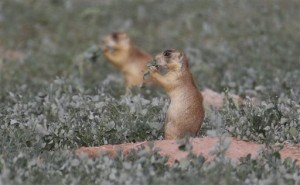
This Aug. 6, 2015, photo, shows prairie dogs, in southern Utah. Utah health officials said Thursday, Aug. 27, 2015, that a resident who died from the plague in August mostly likely contracted it from a prairie dog infected with the disease. State wildlife officials say the only confirmed outbreak of plague in prairie dogs this year was in an eastern Utah colony. (AP Photo/Rick Bowmer)
SALT LAKE CITY — A Utah man in his 70s has died after contracting the plague, bringing to four the number of deaths from the disease reported in the United States this year, health officials said last week.
Officials are still trying to determine how the Utah person contracted the disease, but believe it might have been spread by a flea or contact with a dead animal, according to the state Department of Health.
'That's the most common way to get it,' said JoDee Baker, an epidemiologist with the agency. 'That's probably what happened, but we're still doing an investigation into that.'
Plague is a rare disease that is carried by rodents and spread by fleas. The Centers for Disease Control and Prevention says 11 other cases have been reported in six states since April 1. The other three people who died were ages 16, 52 and 79.
Anywhere between one and 17 cases of the illness have been reported each year in the U.S. since 2000, according to the CDC. Deaths are rare, with no more than two a year having been recorded over the past 15 years.
However, Dr. Paul Mead, a chief of epidemiology with the CDC's office in Fort Collins, Colorado, said four deaths so far this year is not necessarily a cause for alarm.
'Yes, it's twice as many, but when you're dealing with small numbers, you have that kind of variation,' he said Thursday.
Patients in a few of the 11 other cases this year came down with the plague after visiting Yosemite National Park in California.
The last human case of plague in Utah was in 2009, but state Health Department spokeswoman Charla Haley said no deaths from plague have been recorded in the state in at least 35 years.
Haley said the latest patient got the disease in Utah, possibly after being in rural areas and near campgrounds. The person was hospitalized about five days after coming down with symptoms, and died in mid-August at the University of Utah's Hospital.
State health officials declined to release the patient's age, gender or hometown, saying the person's family wanted to keep those details private. However, Mead confirmed the Utah case involved a man in his 70s.
Health officials checked with family members who may have been exposed to the person, but Baker said the incubation period has passed and no family members or anyone else reported symptoms.

JoDee Baker, with the Utah Department of Health, speaks during a news briefing Thursday, Aug. 27, 2015, in Salt Lake City. An elderly Utah resident has died after contracting the plague earlier this month, health officials said Thursday, noting it's the state's first recorded death from the disease in over three decades. State and local officials are still trying to determine how the person contracted the disease but believe it might have been spread by a flea or contact with a dead animal, according to the Utah Department of Health. (AP Photo/Rick Bowmer)
Plague is naturally occurring in Utah rodents and is often seen in prairie dog populations, the Department of Health said. Wildlife and health officials confirmed in July that an outbreak of bubonic plague killed 60 to 80 prairie dogs in an eastern Utah colony.
Annette Roug, a veterinarian with Utah's Division of Wildlife Resources, said Thursday state investigators found prairie dog burrows near the person's property but no sign that animals were still living there.
Roug said if wildlife officials find prairie dog burrows in the area, they may treat them with insecticide to kill fleas that carry the disease. She declined to say where the affected area is in Utah.
Human cases of plague often occur in areas where wild rodent populations are near campsites and homes. Transmission between people is rare.
Baker said anyone going to rural areas or campgrounds can protect themselves by wearing insect repellent; thoroughly cooking any wild game and sanitizing knives and preparation tools; wearing gloves when handling or skinning wild animals; and ensuring pets are wearing flea collars.